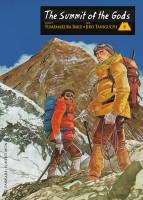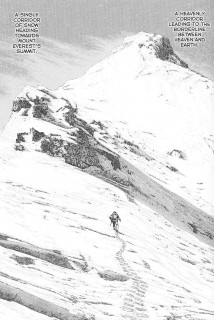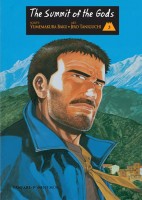 Author: Baku Yumemakura
Author: Baku Yumemakura
Illustrator: Jiro Taniguchi
U.S. publisher: Fanfare/Ponent Mon
ISBN: 9788492444403
Released: July 2015
Original release: 2003
Awards: Angoulême Prize, Japan Media Arts Award
Baku Yumemakura’s novel The Summit of the Gods (which, sadly, hasn’t been translated into English) was published in Japan in 1998 and would go on to win the Shibata Renzaburo Award. In 2000, Yumemakura was paired up with the immensely talented artist Jiro Taniguchi to create a manga adaptation of the novel. The Summit of the Gods manga continued to be serialized through 2003 and was collected as a five-volume series. The manga also became and award-winning work, earning an Angoulême Prize and a Japan Media Arts Award among many other honors and recognitions. In addition to being one of my favorite manga by Taniguchi, The Summit of the Gods is actually one of my favorite manga in general. As such, I was waiting with great anticipation for the publication of the fifth and final volume of the series in English by Fanfare/Ponent Mon. I was thrilled when it was finally released in 2015.
Photographer Makoto Fukamachi followed the legendary climber Jouji Habu to Mount Everest to document one of the most difficult and dangerous ascents to ever be attempted: a solo climb of the southwest face in the winter without oxygen. The agreement between them was that neither one of the men would interfere with the other’s climb no matter what happened. But when Fukamachi’s life is in danger Habu rescues him anyway, putting his own life and the success of his ascent at risk. Fukamachi ultimately survives, returning to Japan to find a media frenzy; not only was Habu an infamous climber, his assault on Everest was an illegal one. And then there’s the matter of the camera that Habu had in his possession. Believed to have belonged to George Mallory, it draws considerable attention once its existence comes to light. Fukamachi’s connection to Habu and to the camera makes him a person of interest as well. Even without the additional scrutiny from the public he would find readjusting to a normal life after his fateful Everest climb to be challenging if not impossible.
 Three stories have become irrevocably intertwined in The Summit of the Gods: the story of George Mallory and Andrew Irvine’s’ final climb and disappearance on Mount Everest, the story of Jouji Habu’s efforts to become the greatest known climber more for himself than for any sort of fame, and the story of Makoto Fukamachi as he strives to untangle his own feelings about climbing and about life by trying to unravel the mysteries surrounding those of the others. The Summit of the Gods can be read in two different ways. It can be approached simply as a compelling tale of adventure and survival or, either alternatively or simultaneously, as a stunning metaphor for any human struggle against seemingly overwhelming odds. Climbing requires great physical and mental fortitude, and life can be just as demanding. The characters in The Summit of the Gods not only pit themselves against nature, they challenge themselves to overcome their own personal weaknesses and limitations.
Three stories have become irrevocably intertwined in The Summit of the Gods: the story of George Mallory and Andrew Irvine’s’ final climb and disappearance on Mount Everest, the story of Jouji Habu’s efforts to become the greatest known climber more for himself than for any sort of fame, and the story of Makoto Fukamachi as he strives to untangle his own feelings about climbing and about life by trying to unravel the mysteries surrounding those of the others. The Summit of the Gods can be read in two different ways. It can be approached simply as a compelling tale of adventure and survival or, either alternatively or simultaneously, as a stunning metaphor for any human struggle against seemingly overwhelming odds. Climbing requires great physical and mental fortitude, and life can be just as demanding. The characters in The Summit of the Gods not only pit themselves against nature, they challenge themselves to overcome their own personal weaknesses and limitations.
Facing oneself—being able to objectively recognize the extent of one’s own abilities and admit the possibility of failure—isn’t necessarily an easy thing to do. It can also be a very lonely thing. This, too, is emphasized in The Summit of the Gods through Yumemakura’s writing and Taniguchi’s artwork. Even when working together, the climbers must ultimately rely on themselves and can only trust and depend on others so far. In the end they face the mountain and face their personal demons alone. The characters also show a constant struggle against their own insignificance, a hard-fought battle to find meaning in their lives. Taniguchi’s vistas are gorgeous and sweeping, showing just how small a person is in comparison to the rest of the world. But this also makes the climbers’ perseverance and achievements all the more remarkable. The Summit of the Gods is a phenomenal work with great writing and fantastic art, effectively telling a thrilling drama that also has great depth to it.




